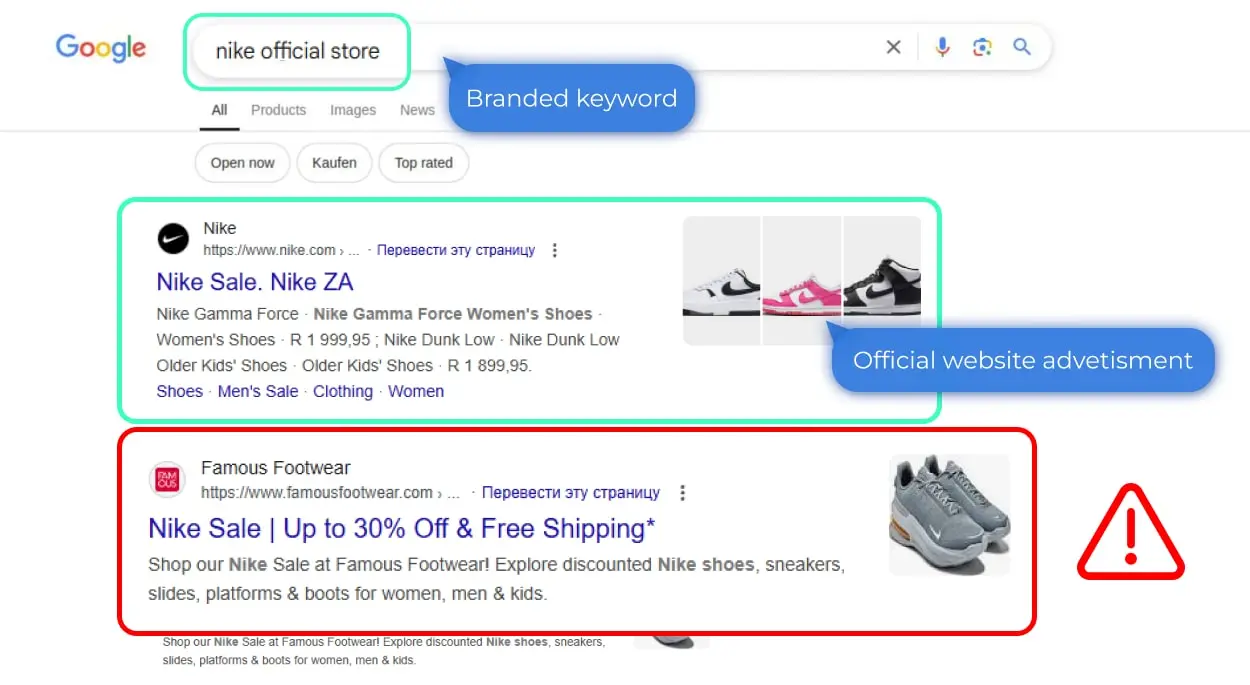
Contents
Protecting your brand online means tracking how your brand’s name and other identity elements are represented in search, social media, and other channels.
Paid search monitoring is vital for brands that aim to save potential clients and use marketing budgets effectively. The reason is that some competitors or affiliates may use your trademark in their paid ads. They do it to take over your traffic and make profit from your efforts. So, if you don’t protect your trademarks in paid search, they may be abused, which will result in your business losing money.
Here’s how trademark abuse looks in real life:
• A user types your brand’s name in Google search to find the official website.
• In SERPs, the first place is taken by your affiliate partner’s or a competitor’s ad that includes your trademarks in paid search.
• The user clicks on the first link without thinking twice and expects to see your official website.
• At best, the user will be redirected to your website through the affiliate’s link and you overpay commission.
• At worst, the user will visit the competitor’s and buy their product instead of yours.
• Even better (not at all), if the user will get to a scam website and lose money while thinking it is your brand’s page.

In this article, we’ll explore how to prevent trademark abuse with smart paid search monitoring. Let’s start with defining the term and then learn how to detect violations and combat them effectively.
What Is Paid Search Monitoring?
Paid search monitoring is the process of tracking how your brand name and keywords are used in paid advertising platforms like Google Ads and Bing. Brands that monitor paid search consistently gain a clearer picture of where misuse starts and how to stop it before it spreads.
Without search engine monitoring, you may face a range of problems:
Traffic theft. Competitors or affiliates bid on your brand keywords to divert users to their own sites. You lose visitors who were clearly searching for you.
Increased CPC (Cost-Per-Click). When others target your brand name, it increases competition in ad auctions. As a result, you pay more just to appear in your own branded searches.
Lost conversions. Users end up on irrelevant or competing pages instead of yours. That means fewer completed purchases, sign-ups, or leads.
Brand reputation damage. Misleading or low-quality ads using your name can confuse customers or make your brand look untrustworthy — even if you’re not involved.
Affiliate policy violations. Some affiliates exploit your brand name to earn commissions they didn’t earn fairly, breaking your program rules and inflating marketing costs.
That’s why paid search monitoring matters — it helps brands detect unauthorized ads, enforce paid search compliance, and take action before damage is done.
Paid Search Monitoring: Preventing Trademark Abuse
Common Violations by Competitors and Affiliates
Both competitors can use the brand name in ads to get traffic that was originally intended for you.
Here are some common examples of such situations:
• Competitors use your brand name in advertising. Some competitors intentionally buy ads using your trademarks in paid search. As a result, a user enters your company name into a search and the first thing they see is a competitor's ad.
• Affiliates violate the terms and conditions and “hijack” branded traffic. Affiliates in your program may start buying ads by brand name to earn a commission. Even though the user was already set up to buy from you, the affiliate earns a percentage for “referring” that customer.
• Disguising ads as an official website. Both competitors and affiliates can design ads as if they were official — with a logo, name, even phrases like “official store”. This is misleading to the user.
These violations harm not only sales, but also analytics, reputation and budget. That's why paid search affiliate monitoring is important. It’s also essential to track how trademarks in paid search are used across ad creatives and landing pages.
How Google Handles Trademark Misuse
Google allows advertisers to bid on branded keywords even if they don’t own the trademark. This means competitors can appear in search results for your brand name without violating policy. To maintain visibility, brands often need to raise their bids on their own keywords.
However, including someone else’s trademark in the ad text is typically against Google’s rules — especially if it creates confusion or falsely implies a partnership. Ads like this can be rejected. Exceptions exist, such as when a site helps users buy branded products or provides factual or comparative information.
To report trademark misuse in Google Ads, start by accessing Google’s official trademark complaint form. Select Google Ads as the relevant platform and proceed to fill out the required details, including your contact information, trademark ownership documents, and examples of the violation.
In most cases, Google responds within a few business days. For complex claims, the review might take up to two weeks. If the complaint is approved, the offending ads will either be removed or edited to comply with policy.
That’s why monitoring how your trademarks in paid search are used is essential for early detection of misuse and for taking timely action.
How to Detect Trademark Violations with Paid Search Monitoring
To monitor paid search, brands use two main approaches: manual checks and automated search ad monitoring.
• Manual monitoring involves regularly searching your brand keywords across different locations, devices, and times to spot unauthorized ads. While this method can work for small-scale checks, it's time-consuming and easy to miss violations.
• Automated tools offer a more efficient solution. These systems scan trademark search results 24/7, track ad placements, capture screenshots, and flag suspicious use of brand terms. They help identify unauthorized bidding, misuse in ad copy, or questionable landing pages.
Tools typically include features like real-time alerts, SERP snapshots, geo-based tracking, and customizable rules for brand protection in paid search. Using these technologies allows companies to detect violations faster, respond quicker, and maintain control over how their brand appears in paid search.
Automating Your Paid Search Monitoring
Automating your search engine monitoring helps brands save time and avoid missed violations. Instead of manually checking trademark search results, an automated system:
• Spots paid ads targeting your brand keywords and detects affiliate IDs in tracking URLs, helping you identify and act on violations.
• Monitors coupon sites, aggregators, and product listings to uncover unauthorized affiliate placements.
• Automatically captures full screenshots of both SERPs and landing pages — useful for documentation, internal use, or filing complaints.
• Sends real-time alerts via email or messenger when potential trademark misuse or affiliate rule violations occur.
• Performs extra checks to confirm if affiliate tracking is present on landing pages, reducing false flags.
• Supports multiple GEOs and proxy providers, allowing you to detect region-specific violations that might otherwise go unnoticed.
• Unmasks cloaked content in real time — revealing when users and brand reviewers are shown different versions of a page.
Automated trademark search monitoring tools offer comprehensive brand protection by detecting violations and capturing evidence.
Best Practices for Ongoing Paid Search Monitoring
Set Up Alerts and Reporting
Monitor paid search with automated tools to get real-time alerts whenever your brand keywords are used in paid search ads by unauthorized parties. This ensures you’re always aware of who is advertising on your brand and how. Also, use automatically compiled reports with evidence to sanction violators. To monitor paid search effectively, consistency and automation are key.
Collaborate with Legal & Marketing Teams
Make sure your legal and marketing departments work together on brand protection. Legal teams can help enforce trademark rights and send takedown notices, while marketing teams handle affiliate relationships and traffic analysis.
Educate Your Affiliate Partners
Provide your affiliates and partners with clear guidelines about how they can and cannot use your brand in paid search. Explain the rules around bidding, ad copy, and landing pages. The more informed your partners are, the easier it is to maintain a compliant affiliate ecosystem.
Take Control with Search Engine Monitoring
Without active monitoring, your brand is exposed to hidden threats — from traffic hijacking to rising ad costs and lost trust. Search engine monitoring puts you back in control, helping you spot violations early and protect your trademarks in paid search.

